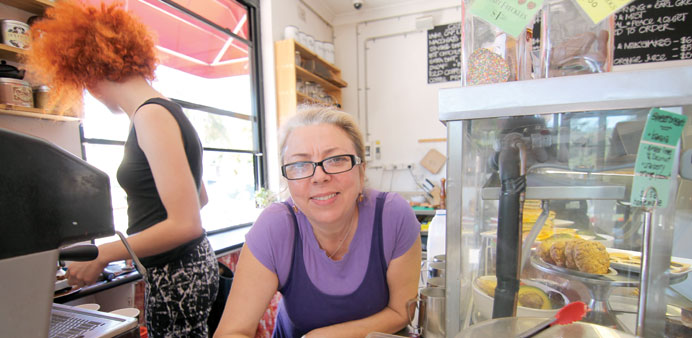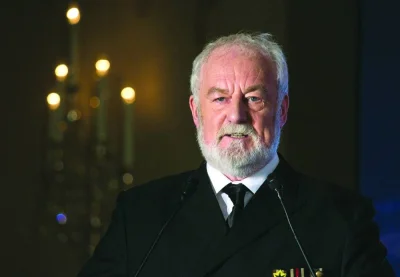* Rose Keeping (centre), proprietor of 3-year-old Rosa’s Kitchen, a Sydney cafe. At left is an assistant. “When I was raised it was boiling water over instant coffee. You added your own milk. Heated milk going into a shot of coffee came from the Italians,” she said.
By Sid Astbury
|
|
Sydney’s very latest café opens for business and Laurence Campbell and Jane Johnson are dazzled by their early success. “We pulled up the shutters this morning and served five coffees straight away,” Johnson bubbles. “No easing in, but it’s great.”
They know that Petiterie, in suburban Stanmore, will stand or fall by the quality of its coffee. Australia is a nation of coffee connoisseurs, with more espresso machines per head of population than any country other than Italy.
Its baristas are in demand around the world and Australian-style cafes are big hits in London, New York and Paris.
“Twenty years ago a good coffee was a filter coffee and that was the top of the line,” Johnson said. “People have just become more refined in their tastes, take a little more time and have an interest in coffee.”
Rob Forsyth, a roaster for 35 years and a judge at international barista competitions, said the switch from instant to espresso began when Italian immigrants brought their machines with them in the 1950s.
“We got into it earlier than other countries,” he said. “It allowed Australians to come from a fresh angle, not the Italian pattern.”
Italians tend to walk in to a café, suck down an espresso and walk out. The Australian café, while the espresso machine has pride of place, is more a meeting place where regulars linger and the barista knows what you usually have.
They are family friendly and more relaxed and egalitarian than places that serve alcohol or high-end restaurants.
Sydney University economist Nick Wailes notes that his father, a sales executive, would meet colleagues or clients in a bar. Now, business meetings like that would routinely take place in a café.
“There’s a far greater proportion of people who’re working independently, or working for themselves, so all of a sudden a place where you can meet to discuss business is much more valuable to you when you don’t have formal meeting spaces,” he said.
“It wouldn’t surprise me if there’s a close correlation between the rise of female participation in the workforce and the decline of the pub and the rise of the café.”
What intrigues him is how intensely competitive the coffee game has become. “It’s not unusual to see a whole row of cafes and one full and the others empty,” he said. “It’s obvious that there’s something going on with one of them. It works for one but the others haven’t got it quite right.”
Rose Keeping, who left a career in management behind three years ago to open Rosa’s Kitchen in Sydney’s Sydenham district, sees her café as helping hold the community together.
“It’s a meeting place. It would be more like an English pub,” she said. “So there’s definitely a contribution there.”
But, again, it’s the quality of the coffee that is paramount.
Keeping’s view is that it is 85% of the business.
“The customer doesn’t know what the difference is, only that they’re having a better cup of coffee at café A than café B,” she said. “It’s the barista at café A texturing the milk properly, making sure the shot has a good rich crema on it every day, it’s sweet not bitter.”
The coffee critics often contrast the fate of two US chains, Starbucks and McDonald’s. Starbucks closed dozens of its Australian shops in 2008 and has just 22 left, according to its website.
McDonald’s, keen to capitalise on local coffee culture, pioneered the McCafe concept in Australia in 1993 when the international operation was headed by Australian Charlie Bell.
McCafes serve espresso coffee, sandwiches and other deli items and now operate in 30 countries.
Forsyth, who runs two cafes of his own, notes gleefully that Starbucks could not compete with the locals. “We thought of them as a milk bar,” he chortles. “It was a huge cup of milk with a little bit of coffee in it. People don’t want that. The Australian palate doesn’t want that.”
He sees the future as more sophistication and greater differentiation. “What’s exciting now is the information that’s coming back from the grower,” Forsyth said. “Now you can Google-up plantations in Guatemala or Kenya and get information on their coffee.”
Australia’s top café drop these days is a double shot in a standard-size coffee cup that is quenched with fresh, full-cream milk.
“They want that lovely strong coffee flavour and not that much milk,” Forsyth, the founder of the Australasia Speciality Coffee Association, said. “They want just enough to enhance the lovely coffee flavour, because milk does that wonderful thing of drawing out the flavour. It’s a great flavour carrier.” — DPA



